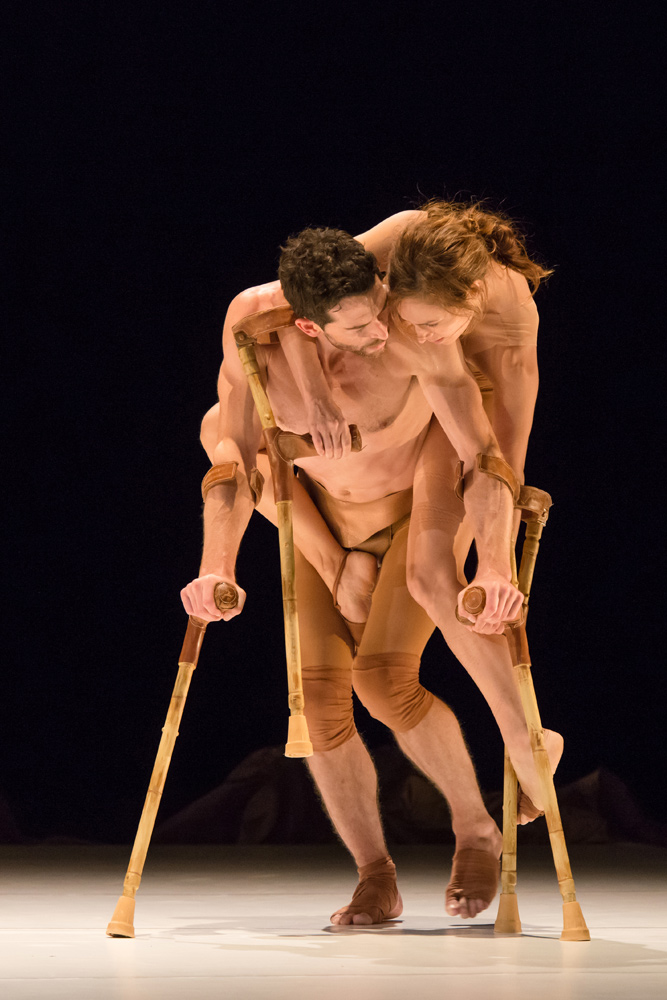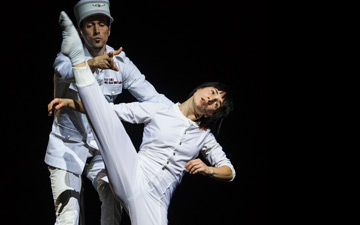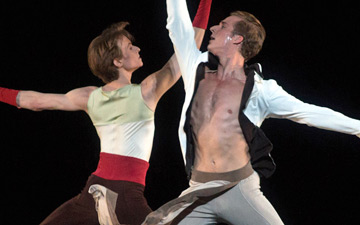
© Foteini Christofilopoulou. (Click image for larger version)
The 7 Fingers
TRIPTYQUE: Anne and Samuel, Variations 9.81, Nocturnes
London, Sadler’s Wells
1 April 2016
Gallery of pictures by Foteini Christofilopoulou
7doigts.com
www.sadlerswells.com
The 7 Fingers is a contemporary circus company from Canada whose previous works have been presented at the Peacock Theatre, Sadler’s Wells more commercial West End offshoot. Now they take to the main stage at Sadler’s with a new programme that provides an unusual combination of circus and contemporary dance. Three choreographers, Marie Chouinard, Victor Quijada and Marcos Morau have all been invited to create works on the company.
It’s an interesting idea to see how successfully the dance makers can use the different skills of the circus performers, and how the performers respond. The three choreographers have quite different approaches and varying levels of success. There are some very striking moments and beautiful images, but some of the works were overextended and judicious editing would result in much greater impact. You are left in no doubt though of the remarkable abilities of all of the company to climb, swing and balance with fearless ease and insouciance.

© Alexandre Galliez. (Click image for larger version)
Marie Chouinard created the opening work Anne and Samuel specifically for Samuel Tétreault (the company’s Artistic Director) and Anne Plamondon, a dancer by training. The opening is slow, almost invisible in the gloom and overly portentous as a figure trudges slowly round the stage. (Possibly this generated more impatience than it might have done, given that there had already been an unexplained 25-minute delay to the start of the performance.) The woman slowly descends, bound to a giant trapeze. Her partner eventually frees her from this, as if from a chrysalis, and gently nuzzles her into life and onto the crutches that both performers use. These give them an insect like quality and are manipulated by both with considerable ingenuity and imagination.
This is the most “dancey” work of the evening, and the one in which the personality of the performers came across most strongly. She perches on his outstretched knee and winds herself around his body in all manner of ways. In one particular section they could have become mating spiders. But though there was some tenderness in the duet there were other discordant notes. If she is a spider, then he just might be her next meal.
Variations 9.81 is from the Montreal-based Victor Quijada, who directs his own dance company – RUBBERBANDDance Group. 9.81 refers to the rate of acceleration of gravity, which the group are set on breezily defying. Quijada uses five performers (two women and three men) and builds the entire piece around their stunning hand balancing skills.

© Alexandre Galliez. (Click image for larger version)
The floor of the set has a series of holes in which hand balancing poles of various heights can be slotted and the performers constantly reconfigure these into different designs, like playing a giant board game. Quijada sometimes uses the group in unison, an upside down corps de ballet, legs and arms waving gently as if trees stirred by the wind. A woman can’t support herself on her feet: she can only walk on her hands. When all the performers gather in a circle it’s as if their legs form some kind of giant flower with quivering petals.
The participants are all, more or less, in street clothes and there is a casual elegance in their expertise, transferring their weight nonchalantly from one perilous pose to another. It’s good to see strong athletic women on stage doing just the same moves as the men. This section of the programme seemed the most successfully realised of the evening to me because the choreographer selected one of the company’s strengths and decided how to use it to best effect. However, the packed audience might not agree as they gave an exuberant response to the last work of the evening.
This was Nocturnes by Marcos Morau, a piece for eight white-clad performers. Its subject is dreams and the state of mind while neither fully awake or asleep. The work centres on a huge bed which is initially a refuge but is then raised and becomes a swing under which the performers duck and weave. Later it is hoisted further up as a giant climbing frame high above the stage. When grounded again, on one end, it keeps springing new surprises as hands emerge through the mattress to clutch one of the women, a peculiarly creepy moment. The work concentrates on the company’s skills in the air with ropes in different forms, and the images where they inhabit the aerial world above the bed, looking utterly relaxed while suspended upside down are particularly striking.

© Foteini Christofilopoulou. (Click image for larger version)
But the work is too long at fifty minutes. It has an uncertainty of tone, at one moment funny and whimsical and at others overly convinced of its own seriousness in some convoluted, and at times grating, spoken narrative. The whimsy works better. A procession of performers all wearing giant fish heads is just the thing that would occur in a dream state. However, Morau can’t resist throwing in more and more incidents, a duet for a man on a unicycle and a female on foot, and then some business with crystal globes. It’s performed with terrific skill and commitment but would be a much tighter and more impressive work with fifteen minutes trimmed off it.
There is always a danger with a hybrid form that admirers of both disciplines might come away disappointed. Here the dance element could be stronger. However, the circus performers’ energy and abilities are never in question and they seem ready for any challenge the choreographers throw at them.

















You must be logged in to post a comment.